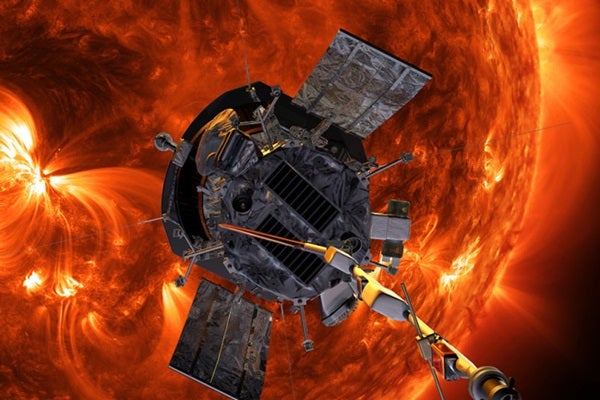Scientists just released the first results from NASA’s Parker Solar Probe, a mission to “touch” the Sun. NASA launched the probe in August 2018, and it has already made a few laps around the Sun. Along the way, it’s brought new insights into the Sun’s outer atmosphere, as well as uncovered surprising facts about the solar wind and the Sun’s magnetic fields.
Over the next few years, the probe will swoop around the Sun several more times, getting closer to it than any spacecraft before it — close enough to fly through the corona, the streaky outer layers of the Sun that are visible during a total solar eclipse.
Researchers designed the Parker Solar Probe to withstand the high temperatures near the Sun. By flying so close to our star, the probe will help scientists better understand the corona and solar wind, the particles that stream out from the Sun and throughout the solar system.
Many mysteries remain about our nearest star, like how the corona is so hot (millions of degrees, versus just a few thousand degrees at the Sun’s surface) and how the Sun creates and pushes solar wind out into space.
In four papers published Wednesday in the journal Nature, scientists described their initial findings from the data the probe has collected so far. Here are some highlights:
- As solar wind blows outward, it also rotates around the Sun much faster than previously thought. The reasons for this are still unknown, but the findings may have implications for how stars slow down their spinning as they age.
- There are dramatic changes in the Sun’s magnetic fields that may be depositing energy into solar wind and speeding it up.
- Part of the Sun’s solar wind, dubbed “slow solar wind,” whose origins aren’t completely understood, seems to come at least partly from holes in the Sun’s corona.
- Measurements of energetic particles traveling from the Sun along its magnetic field imply that the shape of the Sun’s magnetic field could be more complex than previously thought.
- Images taken of the corona reveal a more detailed look at its structure and at how matter leaves the Sun and makes up solar wind.
These initial results show how information gathered by the Parker Solar Probe’s many instruments could eventually reveal some of the Sun’s remaining secrets.
One of the biggest questions about the Sun’s corona and solar wind has been how the Sun transports energy out into the corona, heating it to extreme temperatures and pushing solar wind to faster speeds. Scientists have suspected that magnetic fields have something to do with it, but they didn’t know exactly how the Sun’s magnetic fields would be carrying that energy outward.
The Parker Solar Probe saw dramatic changes in the vibrations of magnetic fields near the Sun, which seem to lose energy going outward. Though the findings aren’t yet conclusive, it’s possible that this could be heating the Sun’s corona and accelerating solar wind.
“I’m not saying we’re done. But it’s pretty awesome that with these first encounters, we’re seeing something really new,” said Justin Kasper, a University of Michigan physicist and one of the authors on the new papers. “I think it’s a really good indicator that we really are going to solve these big problems with this mission.”











